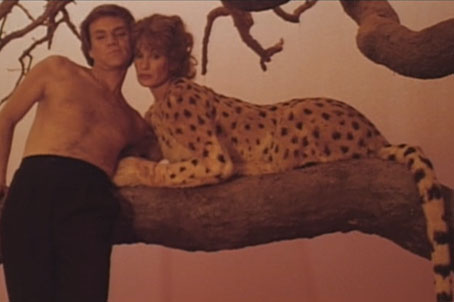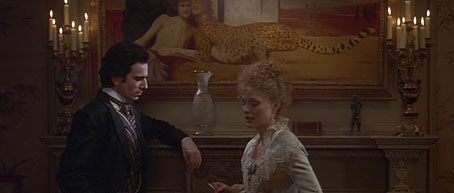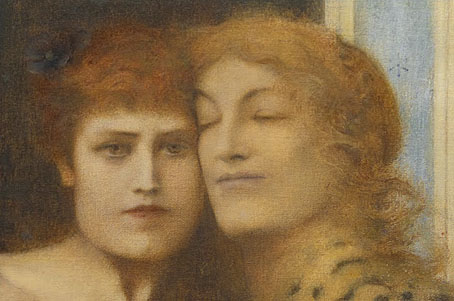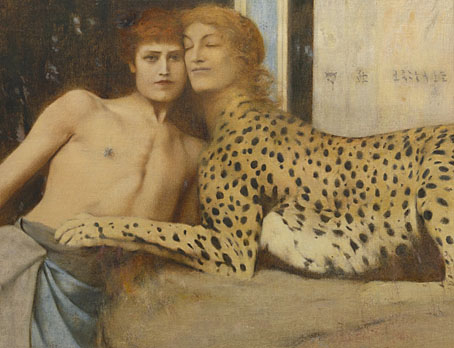Details from Caresses aka The Caress (1896), the most famous painting by Belgian Symbolist Fernand Khnopff which can now be explored in detail at the Google Art Project. Caresses was one of Khnopff’s more enigmatic works although the term is a relative one when it comes to an oeuvre in which enigma is the default position. The combination of a young male, a feline female and the trappings of antiquity suggests Oedipus and the Sphinx although the Sphinx of mythology is a far more threatening presence. Adding to the enigma is the fact that Khnopff’s sister, Marguerite, was his model in most of his paintings which means we can recognise her heavily-jawed features in the male figure as well as the female. The essence of Symbolism for me has always been an atmosphere of unresolved pictorial mystery, a quality which this painting exemplifies.

Malcolm McDowell and Ruth Brigitte Tocki in a deleted scene from Cat People (1982).
The mystery would have been carried over to the cinematic world in 1982 if the producers of Cat People had kept their nerve. The “Leopard Tree” dream sequence was to have featured a moment when Irena (Nastassia Kinski) meets her dead brother and mother in a pose which recapitulates Khnopff’s painting. The painting itself also appeared earlier in the film although it’s so long since I watched it I forget now whether that moment was also excised. The dream sequence may have been stretching audience credulity too far but the symbolism is fitting not least for the incestuous nature of the story. Here’s the scene in the final cut set to Giorgio Moroder’s fantastic score.

Daniel Day-Lewis and Michelle Pfeiffer.
The painting definitely did appear on-screen in 1993 where it overshadows a crucial conversation in Martin Scorsese’s adaptation of The Age of Innocence. Given that the setting is New York in the 1870s the usage is slightly anachronistic but once again the symbolism works for a scene which concerns unacceptable and unrequited passions.
Previously on { feuilleton }
• Symbolist cinema
• Bruges-la-Morte




What on the earth is going on with that young man’s nipples? They appear to be projectile sweating.
I’ve wondered about that for years, they’re like metal pins or encrustations.
Fascinating post as usual – my first reaction on seeing the picture is that it might be related to Balzac’s short story A Passion in the Desert – where a Napoleonic soldier forms a rather close bond with a leopard … it was written in 1830 …
I was scouring the Intertubes for a particular Peter Goodfellow painting and was reminded of his version of Moreau’s “Sphinx”.
http://24.media.tumblr.com/tumblr_maw40bAbCJ1r542x4o1_500.jpg
C. Bottomley: Thanks, I’d not heard of that story.
herr doktor bimler: And I don’t think I’d seen that Peter Goodfellow illustration before either. Similar in tone to the series of pastiches he did for Penguin’s Borges books in the 1970s.
Similar in tone to the series of pastiches he did for Penguin’s Borges books in the 1970s.
I have that edition of “Book of Imaginary Beings”.
I am only coming now to a sense of Goodfellow’s professionalism & willingness to work in a range of styles. I used to associate him with his biomorphic Garden-of-Earthly-Delights covers (“Astra and Flondrix”), and the Vesalius-sourced dissected figures for Philip Dick cover art, but then he could do a respectable pastiche of David Pelham’s Penguin house style:
http://25.media.tumblr.com/tumblr_mdi3g0ZuFb1qagrc1o1_500.jpg
Then he had a Chirico-derived line of architectural surrealism (originally I was looking for an image of his cover for Yates’ “The Art of Memory”, only to be forced in the end to scan my own copy).
Apologies for going so far off-topic with comments more suitable for the next time you blog about Goodfellow’s cover art.
No need to worry about going off topic, this post is about the way one thing leads to another. The Borges covers also featured Vesalius and De Chirico references.
There’s a listing of his sf covers here:
http://www.isfdb.org/cgi-bin/ea.cgi?25963
I can see myself signing up for an account with ISFDB and wasting *even more* time. I didn’t realise that was a Goodfellow cover on Alex Comfort’s “Tetrarch”.
It is nice to think that the design for “Book of Imaginary Beings” is referencing Aldrovandi’s mutant stag, but that’s probably my imagination.
I’ve always thought the Imaginary Beings cover was an amalgam of Boschian motifs with maybe a touch of Bruegel. His painting style in general is like Bosch’s Garden of Earthly Delights while some of his other cover paintings feature minor Boschian extrusions here and there.
http://commons.wikimedia.org/wiki/File:Hieronymus_Bosch_-_The_Garden_of_Earthly_Delights_-_Prado_in_Google_Earth-x3-y0.jpg
I recognise a number of Bosch figures and architecture there — it was their arrangement, bursting out of a mound, that brought the Aldrovandi to mind.
Shameless blogpimping here.
Nice, I’ve got the Borges one (also did a cover for a sequel to that book by another author), not seen the others before.
Further bio-aesthetic note… His sister is actually represented as a cheetah, which adds an over/under-tone to the incestuous theme:
Cheetahs are very inbred. They are so inbred, that genetically they are almost identical. The current theory is that they became inbred when a “natural” disaster dropped their total world population down to less than seven individual cheetahs – probably about 10,000 years ago. They went through a “Genetic Bottleneck”, and their genetic diversity plummeted. They survived only through brother-to-sister or parent-to-child mating.
Cheetah Extinction
Did Khnopff intuit that?